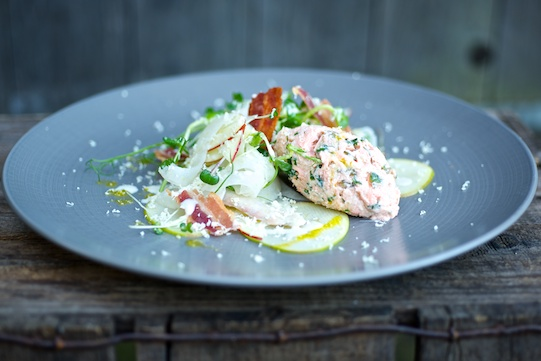Poached Salmon Rillettes with Smoked Eel and Cox’s Apple Salad
For the salmon rillettes
- 250g fresh skinless, boneless salmon
- 250ml milk
- 100ml cold water
- ½ celery stick, chopped into 3 even-sized pieces
- ¼ teaspoon coriander seeds, dry-roasted and lightly crushed
- 1 star anise
- 1 bay leaf
- ¼ onion, cut in half
- 1½ tablespoons mascarpone cheese
- 1 tablespoon chopped fresh mixed herbs (such as chervil, dill, tarragon and chives)
- 1 tablespoon finely chopped (drained) capers
- 1 tablespoon finely chopped (drained) gherkins
- 1 teaspoon creamed horseradish
- finely grated zest and juice of 1 lemon
- sea salt and freshly cracked black pepper
For the smoked eel, bacon and Cox's apple salad
- 4 rashers smoked streaky bacon
- 2 Cox’s eating apples
- 2 handfuls of mixed salad leaves
- 2 tablespoons classic vinaigrette (this recipe is on page 19 in my cookbook; if you do not have my cookbook, use an ordinary plain vinaigrette, one you might have in your fridge)
- 150g smoked eel, flaked
- 1 teaspoon rapeseed oil
Prepare the salmon rillettes. First, poach the salmon. Season the fish with salt and pepper, then place it on a plate whilst heating the milk and water. Pour the milk and water into a small saucepan, add the celery, coriander seeds, star anise, bay leaf and onion and bring to a gentle simmer over a medium heat. Place the seasoned fish into the simmering milk, place a piece of greaseproof paper directly on top of the fish/milk surface and keep the pan over a medium heat for a further 8 minutes.
Remove the pan from the heat and set aside so that the fish cools in the warm poaching liquid. Once cooled, drain the fish from the poaching liquid and flake it into a mixing bowl. Refrigerate the salmon for about 30 minutes or until it is completely cold. Discard the poaching liquid.
While the poached salmon is cooling, start to prepare the salad. Preheat the oven to 180°C/Gas Mark 4. Place the bacon on a baking tray and cook in the oven for 8–10 minutes or until golden and crispy. Remove from the oven and leave to cool. Once cool, break or cut into shards.
Finish the rillettes. Gently fold the mascarpone, chopped herbs, capers, gherkins and creamed horseradish into the cooled poached flaked salmon. Season to taste with salt and pepper and then stir in the lemon zest and juice. Set aside while you finish the salad.
Use a mandolin to slice 1 cored apple into 2mm-thick slices. Arrange them on 4 serving plates, then slice the remaining cored apple even more thinly into a mixing bowl. Add the salad leaves and then dress with the vinaigrette. Season to taste with salt and pepper. Mix in the smoked eel and the shards of cooled bacon.
Use 2 large serving spoons to shape the rillettes mixture into 4 even-sized quenelles (oval shapes) and place one on each plate. Pile the salad next to the rillettes, drizzle over the rapeseed oil and serve with crusty bread.
Serves 4 as a starter or Serves 2 as a light lunch or supper
